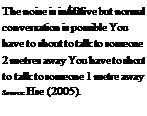Noise in control rooms can arise from sources within the room, such as fans and impact (dot matrix) printers. Fans used to provide cooling to electronic and computerised equipment are often a significant source of control room noise. Impact printers have now largely been replaced by inkjet or laser printers, which are generally very quiet in operation. External noise sources include air-conditioning systems, where the refrigeration pumps, circulating fan, and turbulence in the air emerging from the vents can all transmit noise and raise the noise level in the control room. Air turbulence tends to produce higher-frequency noise. Control rooms are often attached to the structure of the building in which the industrial process being controlled takes place. Where the process produces vibration, this can be transmitted through the walls and to the equipment panels in the control room, and this in turn creates noise in the room. This type of noise tends to be in the low-frequency range.
In an open space, the noise level reduces by 6 dB for every doubling of distance from the source in accordance with the inverse square law. In an enclosed space such as a control room, however, with sound-reflective surfaces, the level drops only while one is close to the source. At a greater distance the noise level becomes constant due to the reflections in the room. The noise level will only drop by between 3 and 5 dB, even at the corner of the room furthest from the sound source. The noise level in a control room can be estimated by the operators using a simple rule of thumb as shown in Table 7.4.
Control room operators tend to spend long periods in the control room environment. If the noise level in the control room is above 85 dBA, then the operator’s daily average exposure is also likely to be above 85 dBA and action would then need to be taken to reduce the exposure of the operator. The best solution to this is to investigate the origin of the noise and to reduce it at source. This then protects everyone in the room, whether operator or visitor. The use of personal ear protection is not usually recommended in control rooms as it reduces the levels of all sounds, not just the background noise, and it can make speech much more difficult to hear. There may be situations, however, where the wearing of hearing protection may be beneficial.
TABLE 7.4
 |
||
Noise in the Workplace Environment



